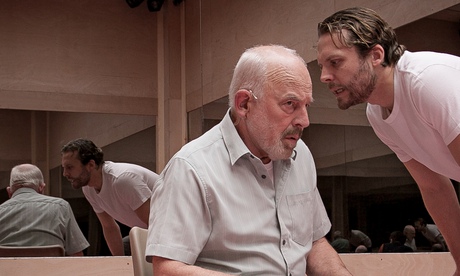 Nuffield Theatre, February 2014. This was my third exposure to Caryl Churchill's A Number (one: radio version with Daniel Craig and Michael Gambon; two: BBC TV with Rhys Ifans and Tom Wilkinson), and seeing the same work three times, each in a different medium, seems appropriately in tune with a work exploring issues of identity and variety within replication. On stage the theatrical conceit is brought out most fully: one actor doubling different roles becomes not just a practical device but the very essence of the piece. How many of us (me) are there? Is anyone who they seem to be? This production cast real-life father and son John and Lex Shrapnel, who found a convincing rhythm for Churchill's realistic yet highly stylized script: sentences tail off, yet the characters never interrupt each other. Sometimes the most naturalistic speech is also the most heightened.
Nuffield Theatre, February 2014. This was my third exposure to Caryl Churchill's A Number (one: radio version with Daniel Craig and Michael Gambon; two: BBC TV with Rhys Ifans and Tom Wilkinson), and seeing the same work three times, each in a different medium, seems appropriately in tune with a work exploring issues of identity and variety within replication. On stage the theatrical conceit is brought out most fully: one actor doubling different roles becomes not just a practical device but the very essence of the piece. How many of us (me) are there? Is anyone who they seem to be? This production cast real-life father and son John and Lex Shrapnel, who found a convincing rhythm for Churchill's realistic yet highly stylized script: sentences tail off, yet the characters never interrupt each other. Sometimes the most naturalistic speech is also the most heightened.
When we say a play 'explores' a theme, it doesn't generally mean it distils some clear philosophical thesis, or adds to our scientific knowledge of a subject. Certainly A Number does neither of these. A play explores the dramatic potential of a scenario, in this case the nightmare of a not-quite-possible-yet world where a man clones a disturbed child and finds the DNA has been further replicated by a scientist. Separately he meets three 'sons', the first mild-mannered, the second (also, I think, the original) apparently psychotic, the third a sort of saint / holy fool who finds the whole business exciting and points out we're all 99% genetically the same anyway. In earlier versions my sympathies had been more with the father (silly chump), but this time darker questions suggested themselves: why did the mother kill herself, exactly? The running thread of claiming compensation seemed more and more a desperate projection of self-recrimination. For all its modernity, the play also belongs in a tradition of the inheritance of guilt, reaching back through Ibsen's Ghosts to the House of Atreus.
If a real-life father-son team wasn't enough of a USP, the Nuffield had another in the ingenious design of Tom Scutt. Only a few evenings before I'd been enjoying his realist Irish pub in The Weir. This time the set was a cell-like box, and the audience was divided into four groups, each one watching from behind a two-way mirror. The actors were thus endlessly repeated in multiple reflections, and the audience - each group was given a group number - were placed in the position of voyeurs or onlookers of some interrogation room. These visuals brilliantly brought out the mood and meanings of the piece. The bare set brought out the chilly emotional world we were in, though the lack of scene change made it difficult to see immediately the difference between the first two sons: Lex Shrapnel changed voice and body language but the identical clothes (why, if the two men were so different?) was a tad confusing. I'd love to know how they suddenly got jackets and an extra chair for the final scene. Behind a screen, with voices heard through speakers, the actors seemed close yet distant. As well as delivering the play with thrilling effectiveness, it was an inspiring prompt to find simple and innovative approaches to our own stage work. Under new director Sam Hodges, the Nuffield is making exciting things happen. I'm looking forward to the next big show, Headlong's production of Anya Reiss's version of Frank Wedekind's Spring Awakening.